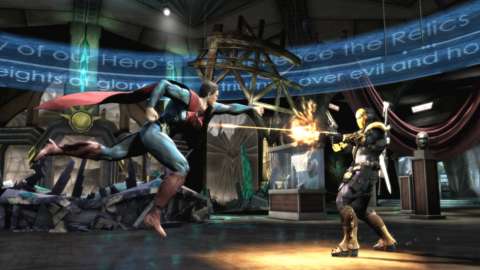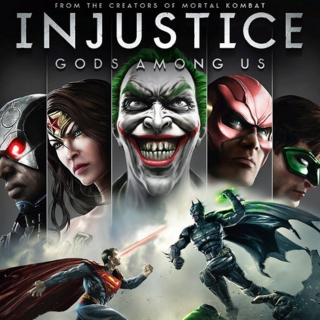We all love superheroes, but superheroes like those of the illustrious Justice League helping the innocents against the evil archetypes of our world. So just imagine an alternate reality: a megalomaniac Superman dwelling in injustice after Joker tricked him to kill Lois Lane pregnant with their son and with this, millions of innocent lives thanks to the nuke trigger linked to her heart: “First Krypton, then Metropolis... People you love tend to blow up.” At the same time, known villains like the powerful Lex Luthor, former friend of the alternate Superman, join the insurgents led by Batman in their effort to get the dystopian situation under control, with the help of the other-dimensional hero counterparts: Wonder Woman, Aquaman, Green Arrow, Green Lantern, whereas still others—Cyborg, Deathstroke, the Flash—remain loyal to Superman turned Supervillain.
Somewhat in the vein of Mortal Kombat vs. DC Universe (2008), Injustice: Gods Among Us' 99 episodes long story pits superpowered heroes against one another, only that this time the MK team chose sides uniquely in favor of the DC All-Stars starring the game. Alike the former and similar fighting games, the cinematic narrative sets the stage for a less arcadish single player experience, while letting the player adopt both the roles and combat styles of twelve of the in total 24 different superheroes featured along its Chapters: Batman, The Joker, Lex Luthor, The Flash, Wonder Woman, finally Superman facing his mirror self in the final encounter: “Put in the same position, I might have done the same thing. We never know what we're truly capable of.” Deprived of his superpowers but with still a red glow in his eyes, the story closes up on Superman in a prison cell awaiting his this-worldly trial.
As likewise the fighting styles, the playable superhero characters justify different combat arenas related to their individual stories: Metropolis, Gotham City, Arkham Asylum, Batcave, Atlantis, Fortress of Solitude, Hall of Justice, Themyscira, Wayne Manor, each of which consisting of up to three different stages separated from one another through a transitional scene to be triggered optionally—to literally send the other flying. Whereas the two-dimensional combat moves as such are more similar to those known from Mortal Kombat featuring Low, Mid, High punches and kicks plus effective Hit combos, and transitions or falling combats were true also in MK vs. DCU, the destructible three-D environments with their interactive objects seemingly make a concession to contemporary Japanese fighting games, as well as the double health bars and the single-round combats whose experience points permit to reach up to level 100 (The Hero We Deserve). Last but not least of the four action buttons, pressing Circle unleashes every hero's Character Power for a short period of time the result of which can be as different as Superman's Fury of Krypton boost (causing increased damage while ignoring armor) and Batman's Mechanical Bats (swarming or projectile bats), while for again others it brings up the weapon or attribute usually related to their character (e.g., Frozen/Electric/Burning Arrows for Green Arrow, highly resilient armor for Doomsday).
In addition to their individual power, each character disposes of a Rage-like Super Move (L2+R2) which can be used once the Super Meter is full making their related emblem—a Diamond S, Bat, Joker, Hawk, or Flash—flicker. Blocked or dodged by the opponent when recognized in time, the Super Move summons the Batcar (The Dark Knight), a Shark (Atlantean Rage), other Amazons (Justice Javelin), or catapults the enemy into space or through the entire planet (Doomsday: Mass Destruction) in an animation of comic-strip-like brutality which unlike the not less spectacular transition ones is individual and does not vary with each combat arena.
“Obedience. Order. Control:” to be mentioned also the story mode's occasional QTE minigames whose successful outcome can give the current character a considerable health/damage advantage over the next CPU opponent (e.g., Batman vs. Lex Luthor). Apart from the health bar and the employed buttons, basic Move data like the damage inflicted with each Attack, Throw, and Hit combo are floatingly displayed on the screen (while other Move-specific Frame data can individually be consulted in the Pause menu), along with the attack quality (low, mid, high) or otherwise self-explanatory words like “unblockable.”
The Access Cards and Armory Keys gained together with the experience points during battle permit the player to unlock alternative Costumes and Concept Art for each superhero, new background Music (Dean Grinsfelder), and other Extras like the customizable Hero Cards, the Battle handicaps, or the additional Match Boost multiplying one's XP for 5, 10, or 25 Matches, respectively.

While the scenes' and cutscenes' excellent graphical quality is comparable to that of Warner's Batman games, the dynamic DC environments are what most stands out in Injustice: Gods Among Us, and the effects caused when interacting with objects and opponents in quick and brutal motions frequently elicit an amazed smile. Moreover, depending on them being either speedy gadget or bulky power characters, each superhero's interplay with the arenas' decorating objects also is different: whenever R1 flashes in the upper left (oneself) or upper right (opponent) corner, an interaction can optionally be triggered which for Superman (power) usually consists in smashing an object—be it a suspended chandelier or a standing spotlight—on the challenger, while Batman (gadget) might use it as support to jump or sway back or forwards where the same item is helping mobility and evasion.
The objects are as varied as imaginative and include warp portals (Fortress of Solitude), rockets (Ferris Aircraft), a slaughtered pig (Arkham Asylum), moving bots (Hall of Justice, Watchtower), a parked motorbike and a grand piano (Wayne Manor), whereas other decoration details—monitors, tubes, statues, fish tanks—may trigger similar actions among characters while adding creatively to the overall destructibility of the scenery. Even after hours of playing, exploring each of the in total 26 background scenes' different features and how they permit to be destroyed and interacted with using the 24 different (plus six downloadable) DC superheroes gets only the more satisfying and eventually is rewarded by trophies such as “Bull in a China Shop” for causing maximum damage in all arenas.
After completing the quite extended Tutorial introducing Basic, Additional, Special, Universal, and Advanced Moves, both the Practice mode furnishing modifiable AI/Practice and Record/Playback options and the Single Fights permit to leisurely explore the characters' and the stages' properties, while the Challenge Tower-like 240 S.T.A.R. Labs missions—ten for each superhero—give plenty occasion to strengthen one's skills before venturing into the hardcore online arena.
As the interactive combat stages alike, the gameplay provides some loopholes for the weaker characters or players to change some tricky fight to their favor: not only does the Super Meter fill up when getting hit by an opponent as well as in performing combos, but a full meter does also permit using the Super Move and enhanced Special Moves that burn portions of the meter on pressing R2 right after a successful combo for a follow-up, or else to interrupt an attack initiating The Clash (>+R2), a wager battle available only once per match and character when down to the second health bar. This way, in yet another short animation, both the player and their CPU or human opponent can secretly bet some meter by pressing the analog action button (Square being weakest, Circle strongest) permitting the defender to gain an amount of health, or correspondingly, the attacker an amount of damage, in accordance with the meter they waged.
The Battles (single player plus Leaderboards) sporting twenty different difficulty levels per character including “Poisoned” and “Injured” with draining or only a quarter of health, or “Survivor” with the health meter being carried over from match to match, and the Versus mode (two controllers) which along with Online Practice allows to fight against a friend, are some of the additional features to be mentioned here, but Injustice: Gods Among Us wouldn't be the great fighting game it is without the Multiplayer allowing to join or create Ranked/Player/Private matches in 1v1, King Of The Hill, and Survivor modes with up to eight slots, letting the players spectate the current match while waiting for their turn. Additionally, the Daily Challenges (e.g., Win a total of 20 online matches with a specific DC character) provide stuff for players determined to fight their way up the world leaderboards.
“May fortune favor the foolish:” while accessible for combat rookies and comic experts alike, Injustice: Gods Among Us offers a great amount of game modes and gameplay elements which in addition to the lengthy story interspersed with cinematic cutscenes does guarantee many hours of fun combat even for hardcore fighters without ever getting overly repetitive.

